Bonny-sur-Loire in Gien
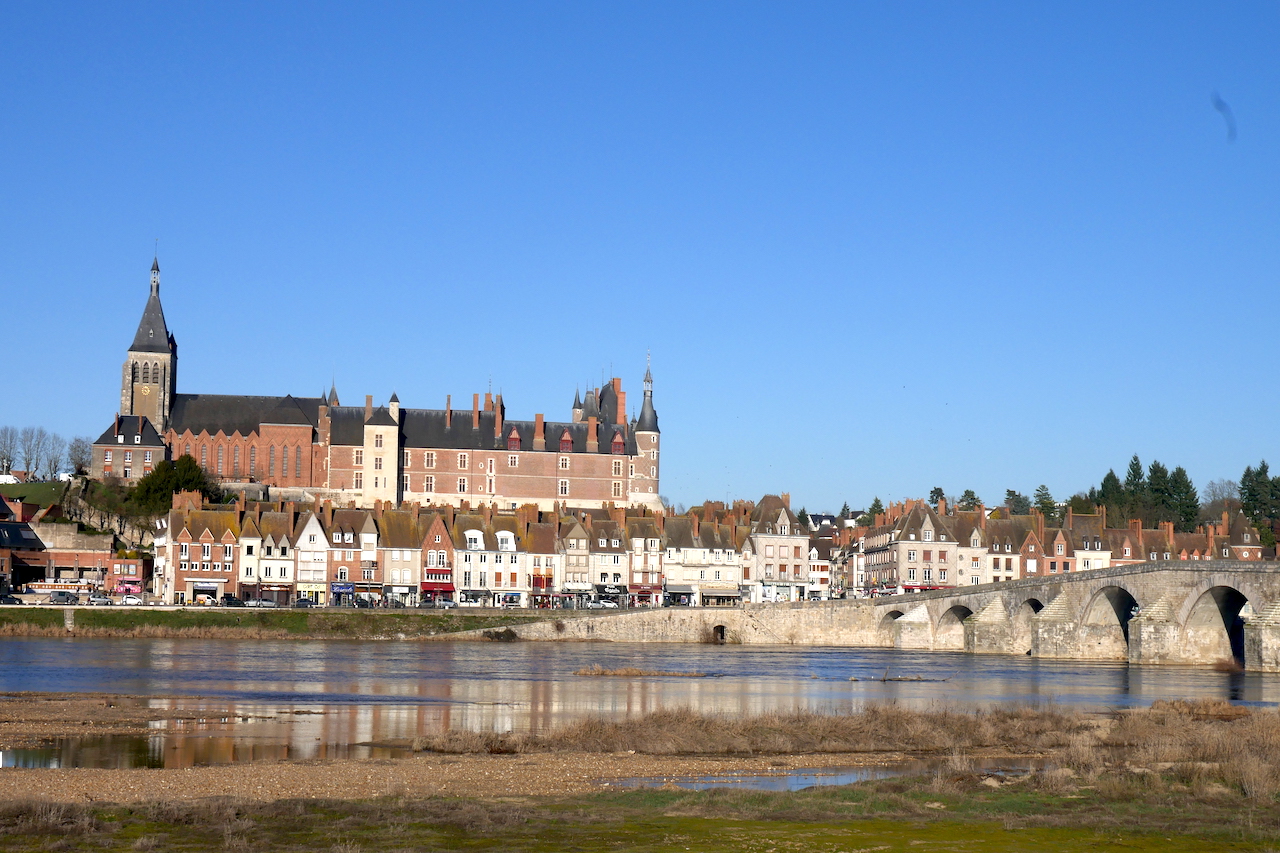
Centre-Val de Loire
14. Bonny-sur-Loire in Gien
Medium
6h30
27,9km
+271m
-262m
Step
Embed this item to access it offline
The word walk is most appropriate at this stage: look, observe, listen and read any information panels that guide you. A 5 km discovery trail takes you around the Bonny Islands to get to your starting point.
You reach the suspension bridge and the lock of Les Combles then the canal bridge of Briare one of the unmissable sites of the Loire Valley, do not forget to visit the town of Briare and its church whose altar is decorated with the famous enamels of Briare. After taking the canal bridge you will discover the imposing castle of Brisson-sur-Loire and your stopover ends in the town of Gien whose castle and church built of bricks dominates the Loire.
You reach the suspension bridge and the lock of Les Combles then the canal bridge of Briare one of the unmissable sites of the Loire Valley, do not forget to visit the town of Briare and its church whose altar is decorated with the famous enamels of Briare. After taking the canal bridge you will discover the imposing castle of Brisson-sur-Loire and your stopover ends in the town of Gien whose castle and church built of bricks dominates the Loire.
8 points of interest
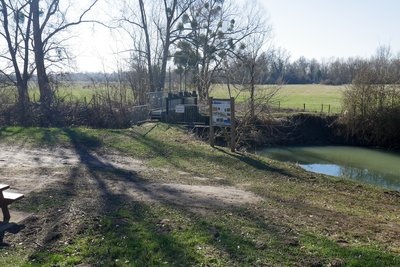
Passerelle pour accéder sur l’île de Bonny - Amis de saint Colomban PanoramicThe islands of Bonny sur Loire
Accessible from Via Columbani.
The islands of Bonny, between the Loire and Cheuille, in the major bed of the Loire, their surface area has greatly increased since the beginning of the 20th century, as can be seen, 500 metres downstream, from the zone of confluence with the Cheuille. The oldest parts contain vast natural meadows, while the most recent parts are made up of sandy strikes. A natural environment that evolves rapidly according to a typical process in the bed of the Loire.
It is a Natura 2000 site, 29 species of birds including the Black Kite, 6 species of mammals including the European Beaver, 270 species of plants... Information panels inform you about the fauna and flora of this protected site.
A 5 km discovery trail takes you around the Bonny islands to get to your starting point by taking a footbridge over the Cheuille.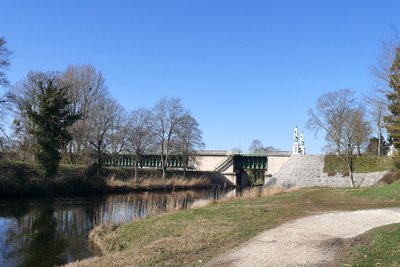
Découverte du pont canal de Briare depuis la Via Columbani - Amis de saint Colomban HistoricalBriare Canal
The Briare canal is the oldest canal with a forebay in France. It connects the Loire valley to the Loing valley and then the Seine valley between several mountains. Begun in 1605 on the initiative of Sully, it was put in water at the time of Louis XIII, 40 years to travel 54 km with 38 locks.
The bridge Canal de Briard dates from the end of the 19th century. Previously boats used to cross the Loire through a dyked channel at the Châtillon-sur-Loire bridge, it is still visible from the Châtillon bridge. The lock of Les Combles, on the right bank, and the lock of Les Mantelots, on the left bank, allowed the levelling of boats between the river and the canal. The lateral canal of the Loire was built during the first quarter of the 19th century at that time the construction of the stone canal bridge was a barrier to the floods of the Loire and was not conceivable. It was not until the end of the 19th century and the mastery of metal structures that an entirely metal canal bridge was built. With its 662 metres in length it will be the longest metal canal until the beginning of the 21st century. The masonry was entrusted to Gustave Eiffel and the metal tank to a company from Creil. The width of the canal is 6 metres with an anchorage of 2.2 metres for a draught of 1.80 metres. Its basin is made of mild steel. The bridge rests on fourteen stone pillars. Entirely made of metal, the waterway is lined with two pavements and a row of street lamps. Its approach is marked on each side by two ornamented rostral columns, the whole evoking the Alexandre-III bridge in Paris.
More details: Wikipedia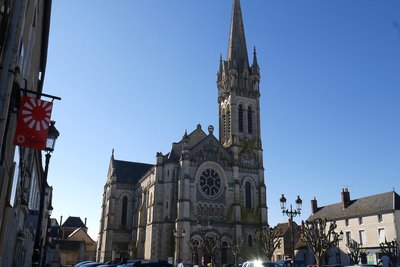
Église Saint-Étienne de Briare-le-Canal - Amis de saint Colomban TouristSaint-Etienne's Church of Briare-le-Canal
Its origin dates back to the 6th century when a chapel already decorated with mosaics and dedicated to Saint Stephen replaced the temple previously dedicated to the Roman god Bacchus. The statutes of Aunaire d'Auxerre consecrated bishop of Auxerre in 570, later Saint Aunaire, mentions it in 596.
It is itself replaced by a church dating back to the 13th century and able to hold a thousand people. The latter, seriously damaged by the flooding of the Loire in 1856 and having become too small given the boom that the town was experiencing at that time due to the importance taken by the enamel factory of Briare, was doomed to demolition.
The general neo-Byzantine style combined with a neo-Gothic bell tower, culminating at 56 meters, is quite rare. The plan is based on a Latin cross with two crossbars and, in accordance with Romanesque tradition, with a wide nave 50 metres long and 12 metres high, which is supported by columns carved with secular motifs.
The high altar honours the Briare enamels.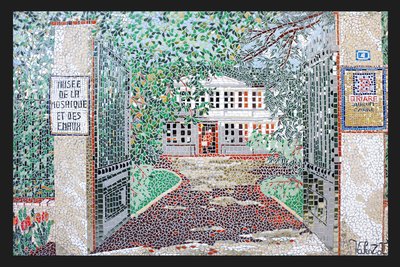
Entrée du musée de la mosaïque à Briare - Amis de saint Colomban HistoricalThe enamels of Briare
On the site where the famous enamels that made French heritage famous in the last century were produced, the Musée des Émaux et de la Mosaïque presents a surprising collection of buttons and beads, as well as small enamel objects made in the Jean-Félix Bapterosses factory in Briare-le-Canal. We find the mosaic works of the painter Eugène Grasset, sparkling with colour and gold, celebrating mosaic in the Art Nouveau period, but also the life-size optical illusions of Victor Vasarely, produced by the factory in the 1970s.
Since 1994, the association has been showing in this museum an astonishing collection of works and objects, witnesses of the rich industrial and social heritage of the Loire basin. Tracing the history of the factory from 1837 to the present day, the museum is a place of memory and transmission of the history of the town of Briare-le-Canal: nearly 1500 workers have maintained the ovens, steam engines, assembled the buttons with colour charts, beads in rosaries and mosaic tesserae in impressive frescoes with perfect regularity!
More info at: Musée des Émaux et de Mosaïque de Briare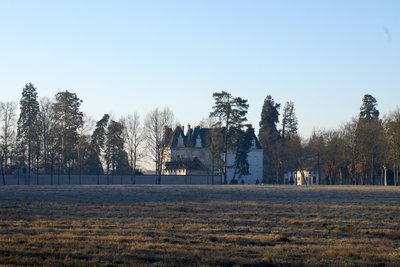
Château de Verdier dans la clairière - Amis de saint Colomban TouristChâteau du Verdier at Dampierre-en-Burly
The Château du Verdier, whose high windows open onto a beautiful pond, in the middle of the trees of the Noue wood, was built by Maxime du Verdier de la Sorinière. Belonging to a noble family from Angevine who had paid a heavy price in the Vendée wars, born in 1813 in Chemillé in Maine et Loire, it became Dampierrois by his marriage in 1842 to Adélaïde de Rancourt, heiress of part of the Marchais Creux estate. It was on his wife's land that he had the castle built after their marriage. He was mayor of Dampierre from 1846 to 1876.
The estate is private and cannot be visited.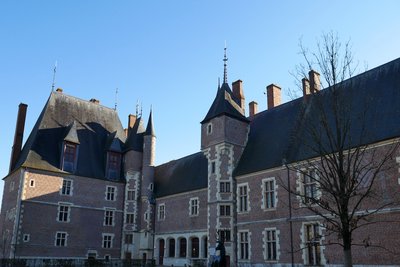
Château de Gien côté cour - Amis de saint Colomban HistoricalGien Castle
In Charlemagne's time a fortress dominated the hill, the building was destroyed in the 12th century. It was not until the 15th century that a new castle was built at the request of Anne de Beaujeu, daughter of Louis XI. Instead of the fortress a Gothic palace was built in polychrome bricks. This new architecture will be appreciated by the royal courts and will inspire the future castles of the Renaissance. Bought in 1823 by the Loiret Department, the castle is used as a showcase, since 1952, the Hunting Museum.
Since April 2017, it is in a completely redesigned museum with a modern museography that the remarkable collections on the techniques of hunting on the fly, running and shooting are now presented, to make them accessible to all and place the history of hunting in the heart of the Loire Valley.
More details : Château-Musée de Gien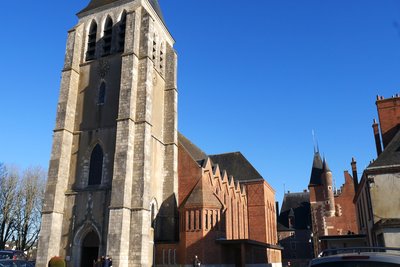
Vue générale de l’église Sainte-Jeanne d’Arc de Gien, XXe siècle. - Amis de saint Colomban TouristSainte-Jeanne d'Arc Church in Gien
The royal collegiate church of Saint-Etienne was built by Anne de Beaujeu, daughter of Louis XI.
It was inaugurated in 1514 in Gothic style. The church was abandoned during the Revolution. In 1832, a new Saint-Pierre church was consecrated. It was bombed in 1940, following a fire, the nave was destroyed. The new church with brick facings will be dedicated to Sainte-Jeanne d'Arc, was inaugurated on March 28, 1954.
The stone bell tower dates from the 19th century church of St. Peter.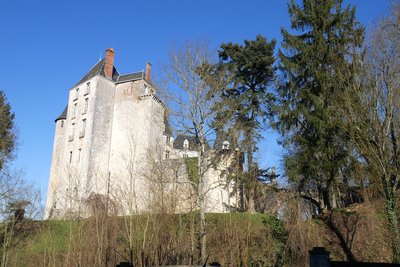
Vue du Château depuis la rue de Gien à Saint-Brisson-sur-Loire - Amis de saint Colomban HistoricalCastle of Saint-Brisson-sur-Loire
The Castle of Saint Brisson-sur-Loire is the most upstream fortress of the Loire Valley.
Already present in the 12th century, the Château de Saint Brisson-sur-Loire was then composed of a Romanesque master tower and palisades. But in 1135, King Louis VI Le Gros besieged and ruined the building. It is in 1210 that the construction of part of the current building began by Count Etienne II of Sancerre, vice-royal chamberlain. In the 16th century, the Château de Saint-
Brisson becomes the property of the Séguier family who abandons the defensive side to transform it into a dwelling house. The Château de Saint-Brisson was bequeathed to the commune of Saint Brisson in 1987 by Anne de Ranst de Berchem.
More details : Château de Saint-Brisson
Description
Leave the church of Bonny-sur-Loire by crossing the square in the direction of the Loire. Turn right on the chemin de la Cheuille and follow the Cheuille and then the Loire for 7,000 metres.
- Cross the D 50 then the Combes lock. If you have time you can cross the Loire and after 1200 meters you visit the town of Châtillon-sur-Loire and its medieval streets built on a hill. Back on the right bank and after the Combes lock follow the canal.
- Cross the Briare canal bridge, visit the town by taking the Saint-Firmin street, left then right, rue Saint-Roch, cross the Place de la République, rue Crouveiller, left rue de la Liberté, cross the Briare canal, Boulevard Buyser at the roundabout of the Musée des Émaux de Briare turn right, rue des Vergers then take the second path on the left, take the footbridge and on the left cross the rue du Val de Martinet continue following the old Briare canal until you reach the Baraban lock which you cross. Follow the old canal to the canal bridge, take the stairs to cross the Loire on the canal bridge.
- After the canal bridge on the left bank of the Loire, leave the canal on your right to take the path below, cross the Grande rue de St-Firmin-sur-Loire, take the path in front of you, rue du Canal.
- At the crossroads, take the second path on your right, cross the brook, straight ahead chemin de la côte de Beauregard, at the crossroads turn right then the second on the left and immediately on the right the dirt track at the exit of the forest, turn right then first on the left.
- After 500 meters turn right immediately left, straight ahead, Chemin des Martins, after the hamlet of Les Martins on the right stay on the main road, rue des Martins.
- After 1 500 meters from the hamlet of Martins, you arrive in St-Brisson-sur-Loire, at the crossroads turn right then left rue du Bizoir, left, rue d'Autry, first right rue d'Enfert, slightly right, rue de la Garenne, take the dirt road, at the crossroads turn right then left straight ahead you arrive in St-Martin-sur-Ocre
- Take in front of you, rue des Cadets, slightly left, rue des Champs de la Croix, at the second crossroads turn right, rue du Puits, second left, rue des Grandes Vignes, next street on the right after the cemetery, Chemin de la rue du Roy straight on the dirt road, turn left to join the tarmac road, Route de la Californie, first road on the right to cross the D 940.
- Turn in front of the water tower and take opposite, rue d'Autry, to the bridge over the Loire. Cross the river, straight ahead, Avenue Leclerc, take the stairs on your left you have arrived at the church of Gien.
- Departure : Saint-Aignan Church, 57 Rue du 14 Juillet, 45420 Bonny-sur-Loire
- Arrival : Sainte-Jeanne-d ’Arc Church, 5 Place du Château, 45500 Gien
- Towns crossed : Centre-Val de Loire
Altimetric profile
Transport
Centre Val de Loire regional buses : Rémi
SNCF train station in Gien
place de la Gare
45500 GIEN
Report a problem or an error
If you have found an error on this page or if you have noticed any problems during your hike, please report them to us here:










